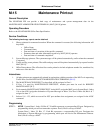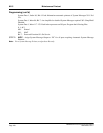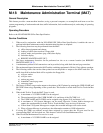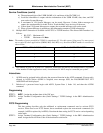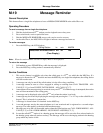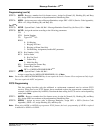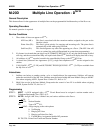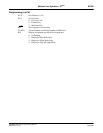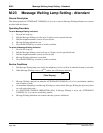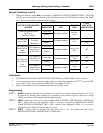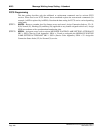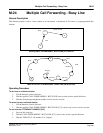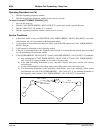
NEAX2400 IPX Feature Programming Manual
NDA-24297, Issue 1
Page 485
Message Reminder - D
term
M-19D
Programming (cont’d)
STEP 3: ANPD - Reserve a number level for feature access. Assign for Normal (N), Hooking (H), and Busy
(B). Assign NND in accordance with predetermined Numbering Plan.
STEP 4: ASPA - Assign an access code to Message Reminder; assign SRV = SSCA (Service Code Appendix),
SIDA = 42; assign Hooking (H), and Busy (B).
For D
term
s
STEP 5: ASYD - System Data 1, Index 80, Bit 1. Message Reminder Cancel Key (for D
term
)0/1=*Note
STEP 6: AKYD - Assign the station according to the following parameters:
TN: 1
STN: Station Number
TP: Type of D
term
0/1:
RING:
0: No Ringing
1: Ringing All Lines
2: Ringing on Prime Line Only
3: Flexible Ring Assignment, enables RG parameter.
KYN: Key Number (1-40)
KYI: Service Index
0: Key Not Used
1: Feature Key
2: Multi-line Key
KD: Not assigned for Feature Key
FKY: Feature Key Number
FKY = 6, MESSAGE REMINDER-D
term
STEP 7: ASYD - System Data 1, Index 80, Bit 1.
Assign a cancel key for MESSAGE REMINDER. 0/1: #/
Note
Note:
D
term
s with a MESSAGE REMINDER key do not require the Service Feature Class assignment. Only single-
line sets require the ASFC assignment.
FCCS Programming
This data setting describes only the additional or replacement commands used to activate FCCS
services. When used as an FCCS feature, these commands replace the non-network commands (for
example, AAED is replaced by AAEDN). Note that the data setting for FCCS service varies depending
on the node. Note
STEP 1: ANPDL - Reserve a number level for feature access. Assign for Normal (N), Hooking (H), and Busy
(B). Assign NND in accordance with predetermined Numbering Plan.
STEP 2: ASPAL - Assign an access code to Message Reminder; assign SRV = SSCA (Service Code
Appendix), SIDA = 42; assign Hooking (H), and Busy (B).
Note: When using ASYDL or ASYDN to program an FCCS feature, the basic programming of ASYD is required
in addition to ASYDL or ASYDN.



